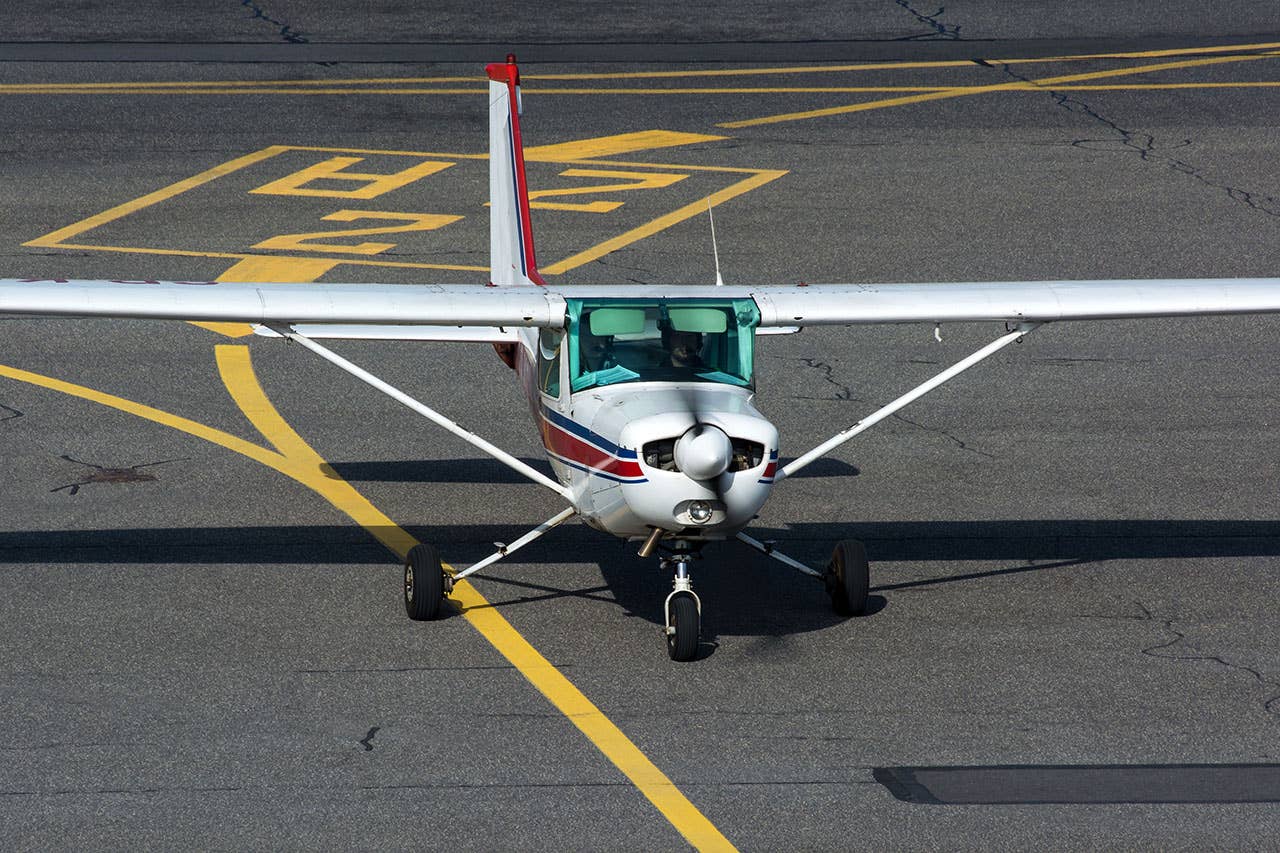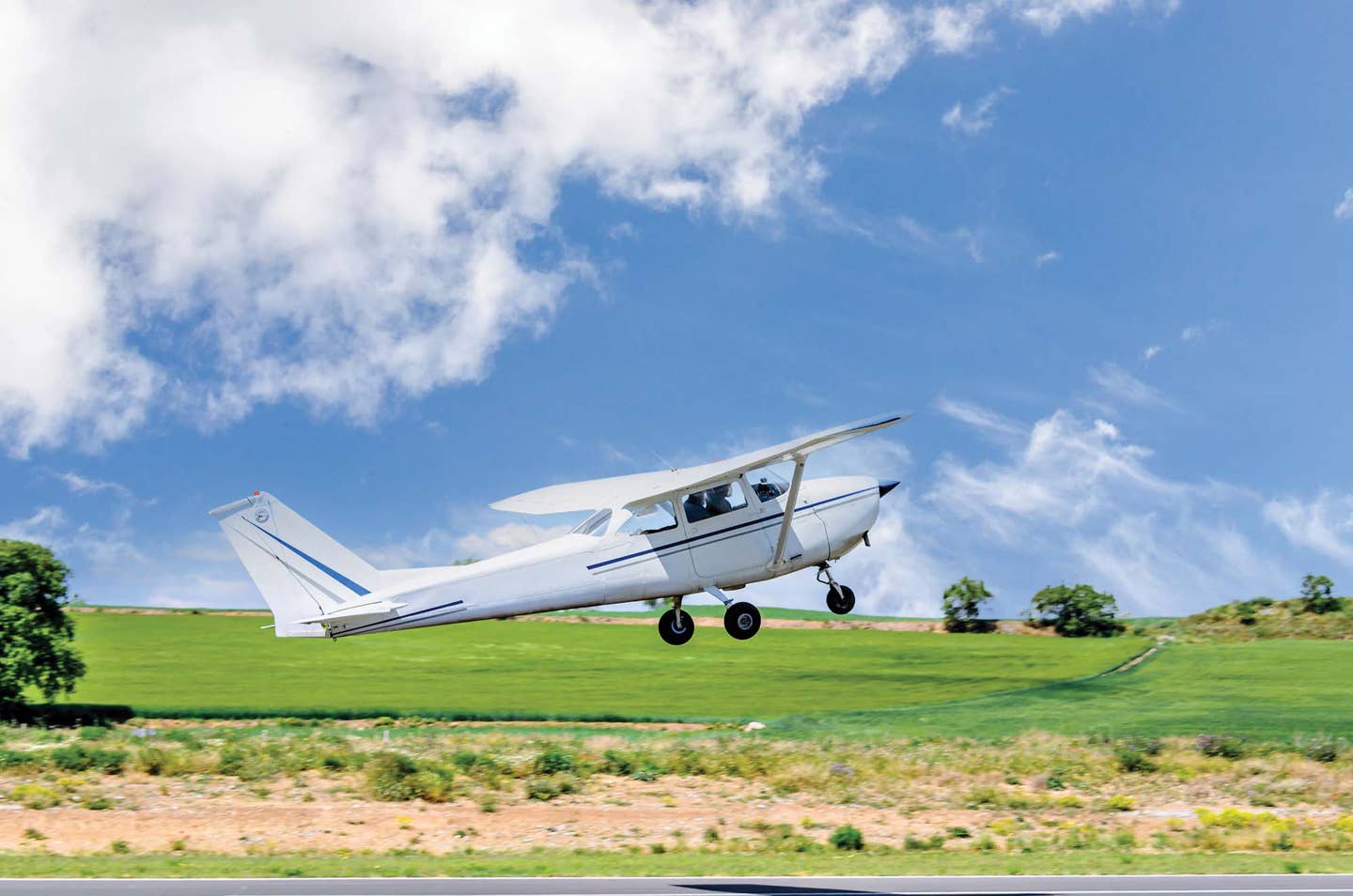Tips To Taxi To And From The Runway Safely
Use this pro advice to avoid incidents.

Why should the crew of an Airbus A 380 or the pilot of a Cessna 172 both study the airport diagram before they start the engine(s) and taxi? Well, back in 2007, the prototype Airbus A 380 embarked on a world tour to promote the new age of super jumbo aircraft. One goal was to find out if the darned thing would fit onto taxiways and into gates at airports around the world. Inevitably, the big (huge?) aircraft/little airport theory came into play. A hangar at the Bangkok international airport claimed first blood, as well as the left winglet of the new Super Jumbo. Because of some additional incidents like this, Airbus A 380 pilots now have airport diagrams that contain special sections outlined in red. These tell the pilots where this behemoth of an airplane can or cannot go!
Ahhh, you say, way down here in general aviation land, our airplanes are small, the airports are big, and so we must have herd immunity from these aviation fender benders. Not so fast! According to FAA statistics, a general aviation pilot is involved in a runway incursion as often as three times a day. And long before reaching the runway, GA pilots are involved in more than their fair share of collisions with other aircraft, light poles, chain link fences, snowbanks and a cornucopia of unique and immovable obstacles. So maybe it's worth our time to discuss some of the FAA's favorite subjects: taxi etiquette, ramp and taxiway safety, and runway incursions.
The Non-Movement Area?
If there ever was a term diametrically opposed to the truth, non-movement area must take the prize. Located in the non-movement area, the typical GA ramp is alive with vehicles, passengers, excited children, loose baggage, pets and all manner of other distractions. Additionally, these ramp areas are not always laid out with our airplanes or operation in mind. Fences are close to the taxiway lines. Ramp center lines are fine if pilots park where they are supposed to, but not all do. Light posts, tie-down ropes and storage chests dot the landscape. And, of course, night lighting ranges from exceptional to nonexistent. So, what to do? Thankfully, our friends at some of the major flight schools have developed "ramp rules" to keep planes, people and obstructions separated.
The first ramp rule is entitled "walking the tails." Spinning props and people don't mix. So set the example and encourage your local populace to walk behind the aircraft rows instead of down the line of spinning props.
Second, no cellphone use on the ramp. These devilish little situational attention thieves cause normally attentive aviators to act like wayward robots. Certainly, there are times while sitting in the aircraft with the engine shut down that the phone is useful for obtaining an updated clearance or weather. However, once the engine starts, the cell phone is a no-go until well away from the ramp.
Third, ensure the traditional "CLEAR PROP" call is accompanied by a thorough visual inspection of the area and acknowledged by nearby bystanders. And, once started, if anyone begins to move toward a spinning prop, shut down the engine immediately. And, of course, never load or unload passengers with the propellor in motion.
Finally, consider taxiing at a walking pace. We have all witnessed a harried pilot rush to the aircraft, rev the engine seemingly to the redline, then lurch out onto the taxiway just short of rotation speed. Unfortunately, these "Darwin Awards" candidates eventually find an immovable object to collide with or worse. The old adage "go slow to go fast" applies here. Take the time required to carefully taxi the aircraft out of the incredibly busy and congested "non-movement area."
Where Is That Darned Runway?
Before the prop turns, it's a good idea to review the airfield diagram. Consider the options the tower has to get you to the runway and be ready to execute. iPad-based applications, especially those with GPS, are a godsend.
For those readers who like to take their single-engine steeds into Class B airports, this pre-study is vital. However, even for Class C and D airports, the taxi routes can be downright confusing. Many of the feeder airports we use are abandoned military airfields with new runways and taxiways overlaid on them. They can contain somewhat confusing taxiway patterns. Knowing the signage cold from the FAA's information manual for aviators is a great start, but a few minutes of strategizing over the airfield diagram before engine start, and before landing, will prepare us for the little surprises that the local pilots have already committed to memory. And remember, if in doubt, ask for progressive taxi!
And while we taxi out, let's just decide that any programming or reprogramming of the GPS can wait until the runup pad. Just like you can with the drivers on the interstate who dial their cellphones while weaving all over the road, you can tell when you are following a pilot hurriedly punching in fixes. Sooner or later, they will snag a taxiway light or put a wheel in the mud. There will be plenty of time in the runup pad to copy that updated clearance and punch in that last-minute flight plan change.
Say The Magic Word!
The four magic words---okay, "phrases"---are "cleared to cross," "cleared for takeoff," "cleared to land/option/touch and go" or "line up and wait." No other combination of words or phrases will do. Yet in 2020, the FAA recorded more than 1,200 separate runway incursions, with more than 800 of them chalked up to pilot deviations. The bottom line is that any activity involving a runway requires a specific clearance. The rules for taxiing across a runway changed about a dozen years ago and require the controller to issue a clearance for each runway that must be crossed. The clearance is runway-specific and should be read back just as spoken. Seems simple enough!
Unauthorized takeoffs and landings also occur with some frequency. Recently, a GA pilot at a major Class B airport received a clearance that read, "your discretion, runway XX, line up and wait for wake turbulence." The pilot apparently thought the "your discretion" referred to takeoff, and after waiting for the appropriate wake turbulence interval, took off. Wrong! Communication can be rapid-fire and occasionally contain some shorthand, slang and jargon. The only guard against this situation is requiring those magic words "cleared for takeoff."
The same discipline applies to landings. At busy reliever airports surrounding major flight schools, pilots often find themselves number three to follow the Cessna. Yeah, right---everyone is in a Cessna today. Just figuring out who numbers one and two are is hard enough. But until the magic words "cleared to land" are heard in the headset, the wheels cannot touch the pavement.
So, What To Do?
Just like our buddies on the Airbus Super Jumbo, GA pilots deal with rapid-fire communications and fast-moving situations on the ground and in the air. Unlike our friends in that spacious double-deck giant, we don't have inflight meals, crew rest compartments or a committee on the flight deck to sort out the communications and clearances. In fact, our single pilot job is often more demanding. Navigating congested ramps, decoding confusing taxiways and avoiding the dreaded runway incursion are full-time jobs. A little time spent with the airport diagram, a dash of ramp etiquette, some good old-fashioned listening skills, and those pesky magic words will get you there safely every time. You are cleared for takeoff; fly safe!

Subscribe to Our Newsletter
Get the latest Plane & Pilot Magazine stories delivered directly to your inbox






